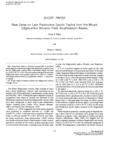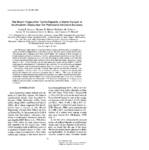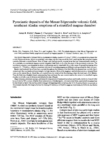Edgecumbe Tephra set (includes Mount Edgecumbe Dacite (MEd) Tephra)
Start: 11250 yBP [1]
Event Type: Explosive
Description: From Beget and Motyka (1998): "A 5- to 15-m-thick deposit of dacite lapilli on the west side of Kruzoff Island is the proximal equivalent of the most widely dispersed Edgecumbe tephra in southeastern Alaska."
"We obtained essentially identical dates of 11,350+/-70 (B-77054) and 11,230+/-70 14C yr B.P. (B-77056) from peat immediately below geochemically correlative dacitic tephra at a newly discovered tephra locality at Greentop on Yakobi Island (Fig. 1 [in original text]). Because these five dates all clearly pertain to the climactic eruption of dacitic tephra, we average them and calculate a date of 11,250+/-50 14C yr B.P. for the major late Pleistocene dacitic tephra eruption of Mt. Edgecumbe volcano."
"These eruptions produced a related group of deposits during a short interval of volcanism; such groups have been referred to as tephra "sets" elsewhere in Alaska and North America (Mullineaux, 1986, 1996). We suggest that the tephra deposits produced at Mount Edgecumbe and nearby vents at 11,250+/-50 14C yr B.P. be informally designated as set ME. This designation would follow the North American convention of using letters in informal tephra nomenclature, while avoiding confusion with numerous other tephras in Alaska which have single-letter designations. There is only one dacite tephra deposit within set ME, which we have informally named layer MEd."
"At proximal sites, layer MEd can be identified visually by its thickness, light color, and texture. At distal sites, layer MEd can be identified by electron microprobe (EMP) analyses or other geochemical methods...A 15-cm-thick ash deposit at a new site along lower Montana Creek in Juneau is composed almost entirely of dacitic glass shards and also marks the most southerly and easterly known occurrences of this tephra. A 10-cm-thick ash deposit at the new Greentop locality to the north also contains abundant dacite glass and constitutes the most westerly known locality of this tephra."
The Global database on large magnitude explosive volcanic eruptions (LaMEVE; 2017) reports a magnitude of 5.9, bulk eruptive volume of 7.0 cubic km, a dense rock equivalent eruptive volume of 3.40 cubic km, and an airfall tephra deposit volume of 6.5 cubic km for the eruption.
"We obtained essentially identical dates of 11,350+/-70 (B-77054) and 11,230+/-70 14C yr B.P. (B-77056) from peat immediately below geochemically correlative dacitic tephra at a newly discovered tephra locality at Greentop on Yakobi Island (Fig. 1 [in original text]). Because these five dates all clearly pertain to the climactic eruption of dacitic tephra, we average them and calculate a date of 11,250+/-50 14C yr B.P. for the major late Pleistocene dacitic tephra eruption of Mt. Edgecumbe volcano."
"These eruptions produced a related group of deposits during a short interval of volcanism; such groups have been referred to as tephra "sets" elsewhere in Alaska and North America (Mullineaux, 1986, 1996). We suggest that the tephra deposits produced at Mount Edgecumbe and nearby vents at 11,250+/-50 14C yr B.P. be informally designated as set ME. This designation would follow the North American convention of using letters in informal tephra nomenclature, while avoiding confusion with numerous other tephras in Alaska which have single-letter designations. There is only one dacite tephra deposit within set ME, which we have informally named layer MEd."
"At proximal sites, layer MEd can be identified visually by its thickness, light color, and texture. At distal sites, layer MEd can be identified by electron microprobe (EMP) analyses or other geochemical methods...A 15-cm-thick ash deposit at a new site along lower Montana Creek in Juneau is composed almost entirely of dacitic glass shards and also marks the most southerly and easterly known occurrences of this tephra. A 10-cm-thick ash deposit at the new Greentop locality to the north also contains abundant dacite glass and constitutes the most westerly known locality of this tephra."
The Global database on large magnitude explosive volcanic eruptions (LaMEVE; 2017) reports a magnitude of 5.9, bulk eruptive volume of 7.0 cubic km, a dense rock equivalent eruptive volume of 3.40 cubic km, and an airfall tephra deposit volume of 6.5 cubic km for the eruption.
References Cited
[1] New dates on Late Pleistocene dacitic tephra from the Mount Edgecumbe volcanic field, southeastern Alaska, 1998
Beget, J. E., and Motyka, R. J., 1998, New dates on Late Pleistocene dacitic tephra from the Mount Edgecumbe volcanic field, southeastern Alaska: Quaternary Research, v. 49, n. 1, p. 123-125.[2] The Mount Edgecumbe tephra deposits: a marker horizon in southeastern Alaska near the Pleistocene-Holocene boundary, 1992
Riehle, J. R., Mann, D. H., Peteet, D. M., Engstrom, D. R., Brew, D. A., and Meyer, C. E., 1992, The Mount Edgecumbe tephra deposits: a marker horizon in southeastern Alaska near the Pleistocene-Holocene boundary: Quaternary Research, v. 37, n. 2, p. 183-202.[3] Marine tephrochronology of the Mt. Edgecumbe Volcanic Field, Southeast Alaska, USA, 2010
Addison, J.A., Beget, J.E., Ager, T.A., and Finney, B.P., 2010, Marine tephrochronology of the Mt. Edgecumbe Volcanic Field, Southeast Alaska, USA: Quaternary Research, v. 73, n. 2, p. 277-292, doi: 10.1016/j.yqres.2009.10.007.[4] Pyroclastic deposits of the Mount Edgecumbe volcanic field, Southeast Alaska: eruptions of a stratified magma chamber, 1992
Riehle, J. R., Champion, D. E., Brew, D. A., and Lanphere, M. A., 1992, Pyroclastic deposits of the Mount Edgecumbe volcanic field, Southeast Alaska: eruptions of a stratified magma chamber: Journal of Volcanology and Geothermal Research, v. 53, n. 1, p. 117-144.[5] Explosive latest Pleistocene(?) and Holocene activity of the Mount Edgecumbe volcanic field, Alaska, 1984
Riehle, J. R., and Brew, D. A., 1984, Explosive latest Pleistocene(?) and Holocene activity of the Mount Edgecumbe volcanic field, Alaska: in Reed, K. M. and Bartsch-Winkler, Susan, (eds.), The United States Geological Survey in Alaska: accomplishments during 1982, U.S. Geological Survey Circular C 0939, p. 111-115.Complete Eruption References
Marine tephrochronology of the Mt. Edgecumbe Volcanic Field, Southeast Alaska, USA, 2010
Addison, J.A., Beget, J.E., Ager, T.A., and Finney, B.P., 2010, Marine tephrochronology of the Mt. Edgecumbe Volcanic Field, Southeast Alaska, USA: Quaternary Research, v. 73, n. 2, p. 277-292, doi: 10.1016/j.yqres.2009.10.007.

New dates on Late Pleistocene dacitic tephra from the Mount Edgecumbe volcanic field, southeastern Alaska, 1998
Beget, J. E., and Motyka, R. J., 1998, New dates on Late Pleistocene dacitic tephra from the Mount Edgecumbe volcanic field, southeastern Alaska: Quaternary Research, v. 49, n. 1, p. 123-125.

The Mount Edgecumbe tephra deposits: a marker horizon in southeastern Alaska near the Pleistocene-Holocene boundary, 1992
Riehle, J. R., Mann, D. H., Peteet, D. M., Engstrom, D. R., Brew, D. A., and Meyer, C. E., 1992, The Mount Edgecumbe tephra deposits: a marker horizon in southeastern Alaska near the Pleistocene-Holocene boundary: Quaternary Research, v. 37, n. 2, p. 183-202.

Pyroclastic deposits of the Mount Edgecumbe volcanic field, Southeast Alaska: eruptions of a stratified magma chamber, 1992
Riehle, J. R., Champion, D. E., Brew, D. A., and Lanphere, M. A., 1992, Pyroclastic deposits of the Mount Edgecumbe volcanic field, Southeast Alaska: eruptions of a stratified magma chamber: Journal of Volcanology and Geothermal Research, v. 53, n. 1, p. 117-144.

Explosive latest Pleistocene(?) and Holocene activity of the Mount Edgecumbe volcanic field, Alaska, 1984
Riehle, J. R., and Brew, D. A., 1984, Explosive latest Pleistocene(?) and Holocene activity of the Mount Edgecumbe volcanic field, Alaska: in Reed, K. M. and Bartsch-Winkler, Susan, (eds.), The United States Geological Survey in Alaska: accomplishments during 1982, U.S. Geological Survey Circular C 0939, p. 111-115.